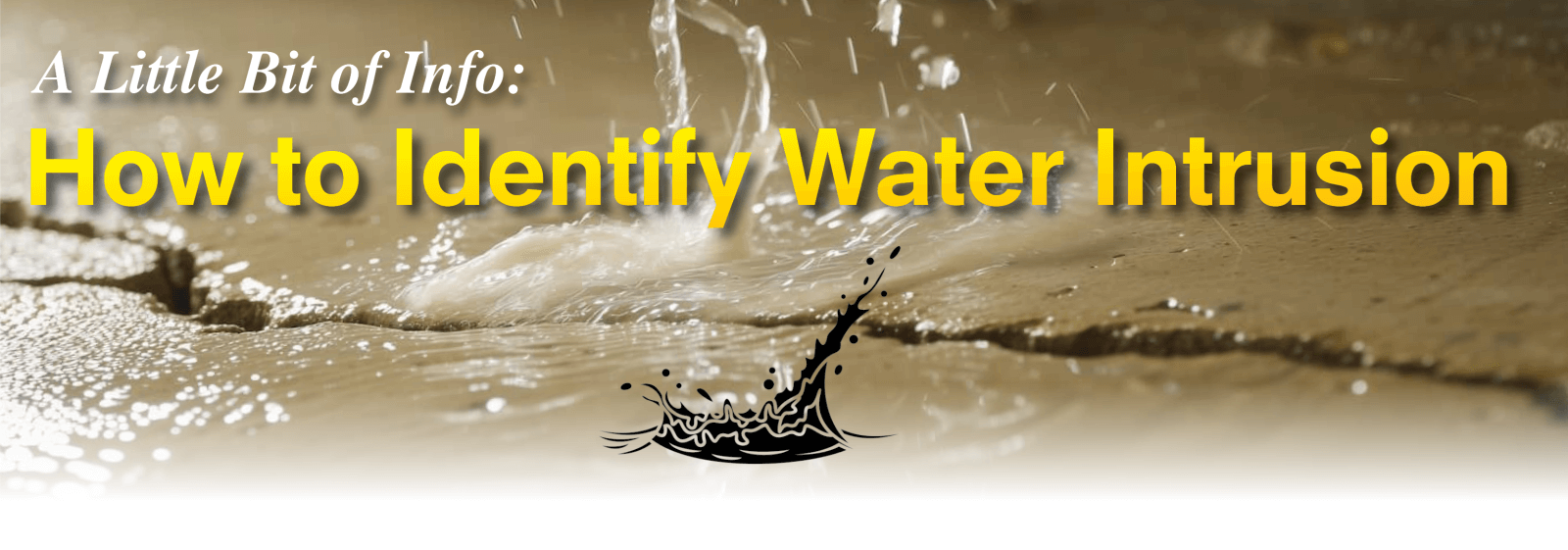A Little Bit of Info: How to Identify Water Intrusion

Any building or home can suffer from water intrusion, which can result in varying degrees of damage. Water intrusion can potentially be the cause of building defects. The signs of water intrusion and damage are not always easy to detect and can be hidden behind your walls, under your floorboards, or on the exterior of your house or building.
What to Look For:
Depending on where the damage has occurred, water intrusion can manifest itself in several ways, including changing the color of the coating or substrate, changing the texture, or emitting different smells. There are several signs that can help find an existing problem.
Discoloration: For water intrusion in areas such as ceilings and walls, look for water spots and stains on the substrate and/or coating. The damaged area may appear wet or dry and can have a change in color to yellow, brown, or copper color. Water intrusion occurring behind walls can also cause bubbling, peeling, or cracking of the coating, in addition to staining.
Changes in Texture: Changes in the original texture of a substrate or coating can be a sign of water intrusion. Swelling of the drywall itself, bubbling or wrinkling of coating/s, or a crumbled masonry substrate are all indications of possible water intrusion.
Odor: Odors caused by mold or mildew could be a sign of a water intrusion problem. The odor can come from any area where water has been accumulating for an extended period of time.
Mold/Mildew: While mold often occurs in areas of high humidity, the presence of mold can also be a sign of water intrusion from leaks in pipes or roofs, as well as cracks in walls, creating moisture problems.
Common Places for Water Intrusion.
Although damage from water intrusion can happen in any part of your home or building, there are some areas that are higher risk than others.
Ceilings: Ceilings could show signs of water damage from a few sources, such as a roof leak or a broken pipe. Staining is typically the first sign of water intrusion, followed by structural damage to the substrate.
Walls: A good sign that water intrusions have occurred in interior and exterior walls is the presence of staining. Unusual or dark stains could be a sign of excess moisture behind a wall. On exterior walls, deteriorated or crumbled masonry substrates or rotted wood substrates can be the result of water intrusion.
Foundations: As the foundations of homes are porous, they can absorb water from outside, resulting in moisture behind the coating. Efflorescence — deposits of salts often seen on the surface of concrete, brick, stucco, or natural stone surfaces — on the surface of the substrate or coating is an indication of water intrusion, as well as peeling or bubbling coating/s. Deterioration of the masonry substrate can also be caused by water intrusion.
Most importantly, showing and understanding potential water intrusion problems is a crucial step before starting a project. Locate the problem area, take any necessary steps to prevent further damage, and follow the right procedure to rectify the problem.
Sales Representative Tim Puckett can be contacted at: Email: tpuckett@roddapaint.com Rodda Paint: 409 M. Thierman Rd. STE B, Spokane, WA 99212Phone: (509) 868-3552

